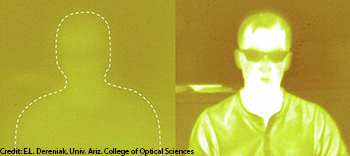
Left: Researcher Jared Griebel’s image was taken through plastic using an infrared camera (ordinary plastic does not transmit infrared light). Right: Image of Griebel taken through a piece of sulfur-based plastic with an infrared camera.
Sulfur waste left over from oil and natural gas refining has potential use as a material for inexpensive, lightweight plastic lenses that transmit at regions of the infrared (IR) not reached by other plastic lenses (Adv. Mater. Online, DOI: 10.1002/adma.201305607). When Jeffery Pyun, professor of chemistry at the University of Arizona in Tucson, U.S.A., began working with waste sulfur (S8) to make batteries, he noticed that it may have useful optical properties as well. Pyun took the material to Robert Norwood, a University of Arizona optics professor, who concurred that the material’s structure and high index of refraction had potential for thermal imaging.
Norwood and colleagues used the cast-off sulfur along with a bonding agent called DIB to mold a simple millimeter-thick window via a reverse vulcanization process. They then compared its characteristics to that of the common polymer plastic, polymethyl methacrylate (PMMA). A window made of PMMA obscured most of the IR heat coming off a body, but the sulfur-based window enabled high-quality, clear images at near-IR wavelengths around 1.5 µm and at mid-IR wavelengths of 3 to 5 µm.
“Other optical polymers used for imaging in the IR region only work well between 1 to 2 µm due to the large number of C-H bonds,” said Norwood. “The only materials that can generally get beyond this with good optical clarity are perfluorinated polymers, which are very expensive. Our material is more analogous to chalcogenide because it’s sulfur-based, but much lower cost and simpler to fabricate with no safety issues.”
The sulfur material is more sensitive to high temperatures than chalcogenide, but may have practical use in many low-heat applications such as lightweight thermal cameras in night-vision goggles, perimeter surveillance or gas-sensing detectors. The advance would make good use of the sulfur left over when oil and natural gas are refined into cleaner-burning fuels.
The researchers have filed an international patent for the chemical process and its application in batteries and as lenses. The next step is to improve the heat resistance of the new material and reduce the hydrogen content to improve IR transmission even more.
